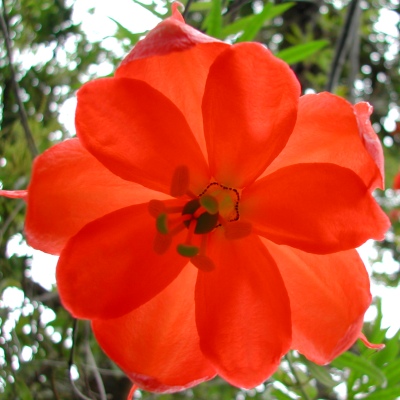Germinating the seeds
When to plant -- Plant your seeds right away for the best results. Soil -- Use a slightly-acid soil mix that is high in organic matter but that also drains well. A typical mix is 3 parts potting soil, coir fiber, or peat moss to 2 parts perlite or coarse horticultural sand. Don't add lime to the mix, unless using peat moss. Pot size - Use pots at least 4 inches tall (10 cm). The pots need drainage holes. Fill the pots with the soil mix and add water until evenly moist (but not soggy). Place a seed on top in each pot, and cover with about 1/4 inch (7 mm) of soil. Moisten the top soil layer. Until the seeds sprout, ensure that the surface soil doesn't dry out. If you place the pots in a plastic container or bag to maintain moisture, leave it open a crack to allow fresh air to enter. Temperature -- Aim to keep them between 64 and 74° F (18-23°C) most of the time. Avoid letting them get above 77° F (25°C) or below 58° F (14°C). I recommend placing a minimum/maximum thermometer near the pots. Keep them in a bright spot out of direct sun. They can begin sprouting in 3 to 6 weeks. Some seeds may take up to 3-5 months. Lighting the seedlings -- Once your seeds sprout, increase the air ventilation a bit, and move them to a bright spot, with protection from afternoon sun. You may use a fluorescent light kept a few inches (10 cm) away while your plants are young. Watering: Once the seedlings are 3 weeks old, you may allow the surface soil to dry out, but aim to keep the rest of the soil evenly moist most of the time. Never let it dry out completely, but also don't keep it constantly soggy. If your water supply is very high in minerals (= "hard water"), I recommend using bottled water or rainwater. Growing onward... Climate -- Established plants prefer temperatures between 40 and 80°F (5-27°C), with nights below 65° F (18°C). Like most other Tasconia-type Passifloras, this one is heat-sensitive, and will drop its blooms if temperatures climb into the 90s (>32°C). Over about 40-50% humidity is recommended. Lighting -- It prefers part-sun, with some protection from strong afternoon sunlight. It can handle full sun in cool, coastal areas. Feeding -- For the first 2 months, i recommend feeding every 7-10 days with a liquid fertilizer that contains micronutrients. Use a light dose, about 1/8 strength. Hydroponic fertilizer is best for this, since it is easily absorbed and complete. After 2 months, you may switch to a granular, slow release fertilizer that contains micronutrients if you wish. If you continue using a liquid fertilizer, increase the dosage slightly as the plant gets bigger. It's normal for an older leaf to occasionally turn yellow and drop, but if it seems excessive, the plant may need more fertilizer. It could also be from the soil being too dry down in the root zone. By the way, it's normal for the leaf blades to curl under, as if the plant is over-fertilized! Repotting -- Once your seedlings have at least 3 sets of leaves, you may repot them to larger containers about 1 quart (1 liter) in size. Repot gently and avoid letting the soil ball break apart. Water the soil before repotting to keep the soil together. For the first week after repotting, shade from sun and give no fertilizer. Repot again after 4 to 6 months. The final pot size depends on how large you choose to let the vine grow. You may prune your plant to any size that is convenient. Pests to watch for -- spider mites (tiny "dots" under the leaves), snails & slugs. Watch for any other pests that affect your other plants. If you have any questions or problems, please contact me. Have fun growing them! - Jeff Strange Wonderful Things
|
|||||||||


